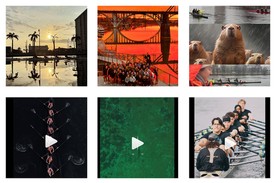Dark Waters: How to Read and Use Currents A ‘Believers in the Stern’ reader wrote recently asking how to account for and use the currents on a river in an upcoming race, having coxed up to now mostly on still waters. I have expanded the answers into what I hope is a helpful column.
The number one thing to know about currents is that they almost always flow faster on the outside of curves. Related to that, the water is usually deeper where the currents have cut into the outside of curves, and shallower on the insides where the slower waters have dropped their sediment. Shoals and sandbars are more likely on the insides of turns. Thus, if you are racing upriver, cutting the inside of the turns (as much as the shallows permit) gives you an edge. By the same token, when racing with the current, it may pay you to go slightly wide around a turn to ride it if the extra speed out-factors the extra distance.
Between curves, the strongest currents (there may be main and subsidiary currents) will take a straight line. This assumes there are no special outcroppings or variations on the bottom to cause otherwise. The core of the current will often cross the river diagonally. (Philadelphia’s Schuylkill River has a noticeable burble at the 800-meter-to-go point.)
Current increases between bridge abutments. The thicker the abutments and the more they “squeeze” the current, the greater the increase. Beware the slipstream effect on the down-current side of some abutments. This can set up some eddies and turbulent water that can keep oar blades from getting purchase in the water (a similar effect as when your blades are not clearing their puddles.
When is it worth steering to take advantage of the effects of the current, rather than to steer the tightest line? There is no clear answer to this, merely a coalescing of variables. Consult with your coach and rowers. It depends on the river, how much recent rain, the state of the tide, etc. Current, like wind, will have more effect on a single than on an eight. As in all things to do with coxing, the more factors you make yourself aware of, the better your overall grasp of each situation will be. It may be sufficient just to be conscious of it and to make small adjustments.
I have coxed on at least four rivers -- two of them unabashedly tidal -- where the current was a major factor and judicious steering to include it was at least a small part of our victories.
The interaction of current and wind is often more consequential than either the current or wind would be alone. Current flowing against wind can set up steep, choppy waves. It will pay you to avoid places where they interact. (Usually visible by the darkening of the water surface.) Warn your rowers about them as you approach so that they can compensate.
Failing to account for current -- even if you are not “riding” it -- can affect the results of races by carrying boats unexpectedly wide on turns and adding substantially to the distance rowed.
So, the above advice is all very well...if you are familiar with the particular river and its currents, and if you and your teammates have spent your formative years throwing sticks into it and watching how the current carries them. But what if you are about to race on a river you have never been on? How to nullify some of the home course advantage that the local rowers and coxswains will have?
Faster flowing water tends to look darker and the waves “stretched” and more rounded. Especially in satellite photographs. Surf the web for “reconnaissance” photographs on the regatta web site (or on the web sites of the home crews). Taken at the right time of day, or in the right light, they might show helpful indications. For example: do the wakes of several crews bend in about the same places; pay attention to the crews that are the home crews and the courses they steer.
A few caveats: some satellite images are montages of photographs taken days or months apart (variations in light or wind could make sections of them look lighter or darker for reasons that have nothing to do with current). Also, if the current is picking up a lot of light-colored sediment, this might make the faster flowing water look lighter. The sediment will still help you, however, as it makes the whorls and eddies that much more visible.
If you enjoy and rely on row2k, we need your help to be able to keep doing all this. Though row2k sometimes looks like a big, outside-funded operation, it mainly runs on enthusiasm and grit. Help us keep it coming, thank you! Learn more.
- Bont Rowing
- Calm Waters Rowing
- Concept 2
- Craftsbury Sculling
- The Crew Classic
- CrewLAB
- Croker
- Durham Boat Co.
- Empacher
- Faster Masters
- Filippi
- Fluidesign
- h2row.net
- HUDSON
- Live2Row Studios
- Nielsen-Kellerman
- Oak Ridge RA
- Peinert Boat Works
- Pocock Racing Shells
- Race1 USA
- RowKraft
- Rubini Jewelers
- Vespoli USA
- WinTech Racing
- Bont Rowing
- Calm Waters Rowing
- Concept 2
- Craftsbury Sculling
- The Crew Classic
- CrewLAB
- Croker
- Durham Boat Co.
- Empacher
- Faster Masters
- Filippi
- Fluidesign
- h2row.net
- HUDSON
- Live2Row Studios
- Nielsen-Kellerman
- Oak Ridge RA
- Peinert Boat Works
- Pocock Racing Shells
- Race1 USA
- RowKraft
- Rubini Jewelers
- Vespoli USA
- WinTech Racing

















